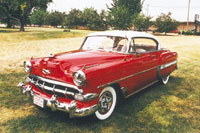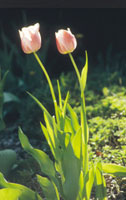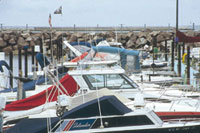Update
Tamron 28 to 300mm Zoom Lens
For extreme convenience a
zoom lens with an ultra-wide range can make taking top quality images
at a variety of focal lengths very practical. One example of this new
breed is the Tamron 28-300mm f/3.5-6.3 AF Aspherical LD lens which encompasses
practically every focal length needed by most photographers in its whopping
10.7x zoom range. In addition, it does this task very capably based
on the results of my extensive tests over several of Minolta Maxxum
9 Professional and Maxxum 800si AF SLR bodies. |
|||
The lens is a handsome flat
black with legible white markings showing the distance in feet and meters
at the front end plus the focal length at the rear near the bayonet mount.
When the lens is zoomed out magnification ratio marks are visible, again
in feet and meters. The zoom ring is extra wide with grip grooves in the
rubberized covering which assist for holding it tightly and actuating
the zoom. Toward the front of the lens is a narrow ring, which moves when
the autofocusing takes place, so it should not be held, as this would
hinder the focusing. When the autofocusing is switched off (on the camera
body with Nikon/ Minolta/Pentax AF SLRs or via an AF/MF switch on the
lens on Canon EOS AF models) this front ring is used for manual focusing. |
|||
Unlike some other easy-operating
zoom lenses I have used, this lens seems to stay at the selected focal
length anywhere throughout the broad zoom range without tending to self
extend or collapse when you point the lens toward the ground or sky respectively.
Even so, there is a special sliding zoom lock switch mechanism built-in,
which will positively lock the lens at one focal length, but only at the
fully recessed 28mm focal length. You can still shoot with this lock engaged
but you cannot zoom out to another focal length until the lock is disengaged.
|
|||
While the lens is of moderate
size and weight it is easy to use handheld, you do have to be extra steady
when holding and recording images at the longer (100-300mm) focal lengths
or you can inadvertently have camera movement, which can degrade the image
detail. In addition, even though the camera's programmed automation
will automatically select a faster shutter speed to minimize possible
camera movement, this also means that the lens will often be operated
nearly wide open (f/6.3), so there will be considerably less depth of
field at these telephoto focal lengths. Because of this, I tended to use
a slightly faster ISO film speed than I normally would outdoors to enable
me to use faster shutter speeds and still have the lens stopped down slightly.
|
|||
The custom-notched front lens
hood is rather broad as would be expected so it does not vignette into
the 28mm coverage corners. But, if you use the pop-up, built-in flash
found on most any brand of SLR camera, it is advisable to remove the lens
hood to minimize the possibility that it might block some of the light
and thus cast a shadow into the lower portion of the image. |
|||
Technical Specifications Maximum Aperture:
f/3.5-6.3 |






































